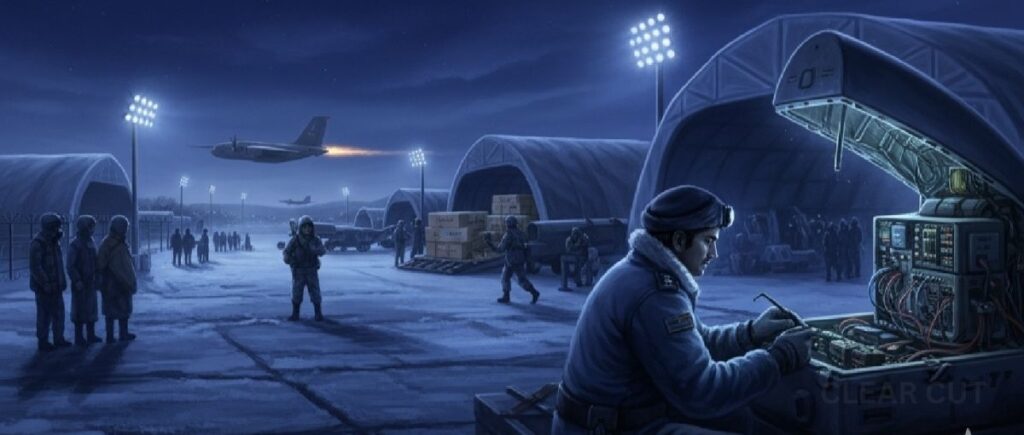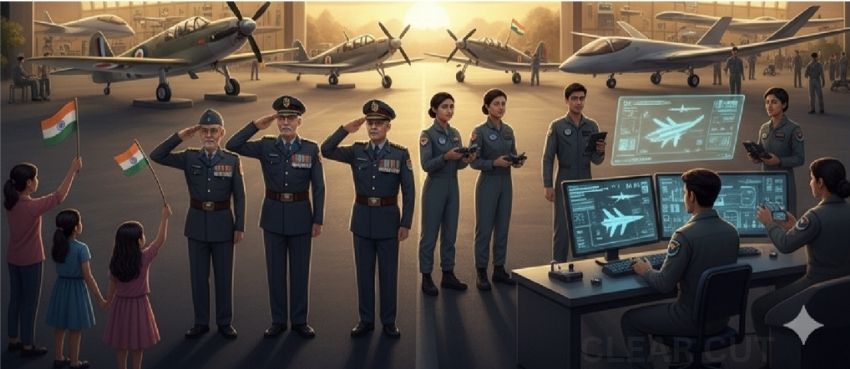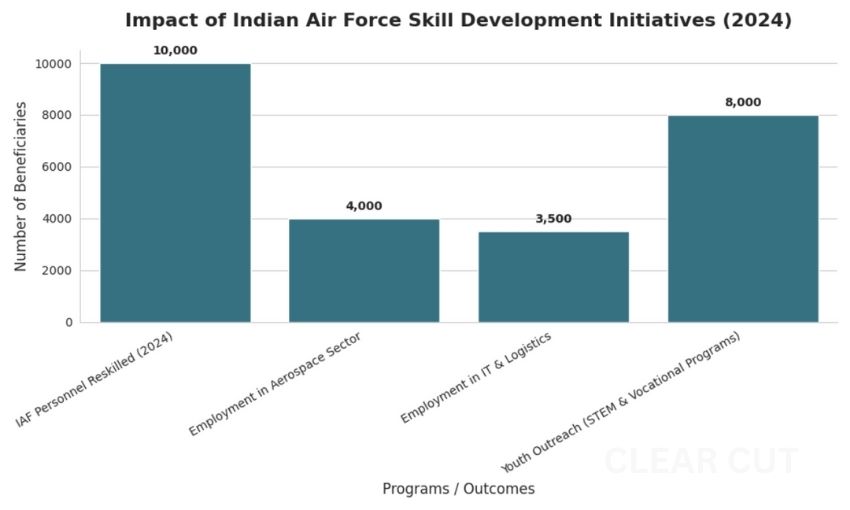Photo Credit: Antara Mrinal
Clear Cut Livelihood Desk
New Delhi, UPDATED: Oct 08, 2025 02:45 IST
Written By: Antara Mrinal
As the Indian Air Force (IAF) celebrates its 93rd birthday on 8 October 2025, it is at an important moment: the line between tradition and rapid technological change seems to have been crossed. The events at Hindon Air Force Station this year, are more than a display of flypasts and drill; an air arm is attempting to close gaps on capabilities, to utilize indigenous design, and adopt advanced technologies, such as unmanned systems, artificial intelligence, etc., into everyday practice (The Economic Times).
Recent Acquisitions and Capability Shaping
Visible additions and ambitious purchase plans have developed over the last few years. The multi-role Dassault Rafale (a high-profile G2G acquisition) has moved fully into operational frontline units with discussions on a follow-on purchase of additional Rafales through a G2G arrangement to help enhance the IAF’s immediate punch capability. Simultaneously, the indigenous Light Combat Aircraft (LCA) Tejas program has transitioned from prototype to production scale with a large Tejas Mark 1A contract that is meant to bring a significant indigenously built fighter into service. Transport and rotary assets too have been added to support humanitarian response and mobility operations. All of these procurement decisions suggest a two-track approach: quickly procure proven foreign platforms to establish readiness in the near term while gradually expanding domestic acquisition to develop long term strategic autonomy (AeroTime).

Missions, Operations, and the Human Element
The IAF’s identity is established in operations, which span quick-reaction air patrols and deterrent combat sorts to large-scale humanitarian airlifts and disaster aid on the ground. The air force has undertaken complex evacuations, provided medical and relief logistics across floods and earthquakes, and participated in multinational exercises aimed at improving interoperability in recent years. Yet, those are only the headlines in terms of the service’s intangible backbone: pilots delivering long and out-of-hours flight periods, and maintenance crew turning jets into mission-ready aircraft in the icy cold and blistering heat. Individual accounts – a young flight lieutenant conducting relief flights over the Himalayan passes, a warrant officer who spent nights repairing avionics under blackouts, families living with the uncertainty of each sortie – are the personal accounts transforming strategy into service. On this Air Force Day, tributes certainly celebrate not only those fearless fighter pilots, but also the often-unseen technicians and engineers whose unwavering support in hand is pivotal to making it all happen (Doon Defence Dreamers).
Drones, Autonomy and Artificial Intelligence
If the last two decades were defined by stealth and precision, the next decade will be dominated by autonomy, sensors and data. India’s defence planners and the IAF are becoming increasingly clear on having unmanned systems, ranging from tactical reconnaissance drones to armed remotely piloted strike aircraft, become part of the order of battle. The recent decision by the government to procure medium-altitude long-endurance systems and local efforts to develop stealthy RPSA-class platforms reflects a strategic pivot: unmanned systems will assume high-risk high-persistence roles that free up manned platforms for decisive actions (oe.tradoc.army.mil).
In addition to drones is a flood of AI capabilities for maintenance, logistics, intelligence, surveillance, and reconnaissance. A predictive-maintenance tool driven by machine learning is being piloted to predict high-failure components and reduce aircraft downtime, resulting in improved availability and lower sustainment costs. AI will facilitate quicker sensor fusion – sewing together radar, electro-optical and signals data to build actionable pictures – and more efficient mission planning to evaluate threats. While AI increases tempo and decision advantage, it also raises doctrinal and ethical concerns about autonomy and lethality, as well as resilience against adversarial interference. Indian ministries and organizations in the domain are proceeding cautiously but decisively toward a codification of standards for safe and accountable use (IndiaAI).

Aerospace Innovation: Engines, Sensors and Indigenous Design
Beyond infrastructure and software, India’s aerospace engineering capabilities continue to deepen in propulsion, avionics, and materials. The Tejas programme led by HAL, along with academic collaborations and entrants from the private sector, are building a diversifying industrial base for airframe subsystems, AESA radars and electronic warfare suites. While investment into domestic engine development remains a critical bottleneck, running production of airframes and gradual indigenisation in avionics represent structural change: India is striving to transition from an importer of complex systems to a designer and manufacturer, which will take over a decade but is important for strategic depth.
Growth, Gaps and the Push for Indigenisation
The recent trajectory of the IAF has been marked by considerable modernization with continued structural challenges. Although the arrival of modern fighters and transport platforms has freshened parts of the fleet, the service is still operating beneath its sanctioned level of squadrons – often the view in defence assessments and public briefings. It is this shortfall that is driving urgent procurement and indigenous production: every indigenous Tejas jet rolling off HAL’s line, more interest in more Rafale fighters, and a growing tilt towards domestic avionics and sensors.
Challenges Looming: Numbers, Doctrine, and Integration
Modernization is not only about platforms; it is also about doctrine, training and integration. A steady production pipeline for pilots, aircraft and sustainment ecosystems, is required to reach sanctioned squadron strengths. Integrating swarms of drones, AI decision aids, and manned fighters, into coherent doctrine, will take experimentation, relocation of scarce human capital, and secured communications. Upgrading logistics and maintenance chains to support distributed operations around India’s varied geographies is needed. Finally, as the IAF commits to software and data, cybersecurity and robustness of algorithms will become mission-critical imperatives.
Tribute, Pride and the Next Generation
Air Force Day 2025 represents, above all, a day of homage to sprightly veterans whose military careers have spanned piston engines to supersonic jets, the families whose contributions continue to go unrecognized and acknowledged, and a renewed generation of airmen and women who will coexist with drones and advanced AI capabilities. The IAF’s public displays flypasts, parades and static exhibitions as part of official displays and also the option for them potentially to occur in communities, represent a way of picturing both an important past and aspirational future. As the service celebrates 93 years, its primary challenge remains changing recent procurement momentum and comfort with some emerging technological acceptance, into enduring operational advantage, while continuing to encourage courage, discipline and the bonds with everybody as has always been the IAF’s operational strength (The Economic Times). India commemorating this day acknowledges and remembers the roar of jet engines, the quiet night at forward bases, the experienced calm while in maintenance bays, and the determination of engineers at work in hangars and laboratories. The IAF of 2025 is an organization, simultaneously valuing tradition and providing developmental processes for how to formulate future air power, furthering that the wings of pride now possess and carry more than just canvas and metal, they now rely and include circuits, algorithms and sensors.

Building Livelihoods Beyond the Sky
In addition to its imposing presence in the skies, the Indian Air Force (IAF) has historically been an accelerator of skill development, discipline, and livelihood generation throughout India. Each one of its pilots, technicians, radar operators, and logistician is not just a member of a defence force, but a highly skilled professional trained to precision, innovation, and leadership. Of India’s 1.4 million active and reserve military personnel, a healthy portion of this human capital is attributable to the IAF – developing individuals whose technical know-how and managerial capabilities reach well beyond the airbase. Through programs such as the IAF Skill Development Initiative and the Mission Raksha Gyan Shakti, it has partnered with the national Skill India Mission to ensure that all serving, and retired air warriors have vex tax high-quality, recognized certifications that link easily to civilian experiences.
The IAF has a structured technical training system from aircraft maintenance and avionics through to cyber defence and aerospace engineering that serves as a natural pipeline to India’s burgeoning industrial sectors. As evidenced by partnerships between the IAF, the Ministry of Skill Development and Entrepreneurship, and organizations like the National Skill Development Corporation (NSDC), skills acquired in the defence sector are now formally acknowledged through the Recognition of Prior Learning (RPL) framework. This means that an airman, for example, trained in turbine maintenance or communication systems, is now able to transition to the aviation, automotive, or manufacturing sectors with certified skills. For instance, in 2024 alone, over 10,000 IAF personnel retired and benefitted from reskilling programs, helping them to find employment across sectors, such as aerospace manufacturing, IT services and logistics.

In 2024, close to 10,000 IAF personnel were reskilled under structured certification programs implemented through reskilling initiatives associated with Skill India Mission and Mission Raksha Gyan Shakti. Approximately 4,000 of these newly qualified individuals worked in the aerospace sector, working in aircraft maintenance, manufacturing, and quality assurance. Another 3,500 were employed in the IT and logistics sectors, drawing upon their skills in communication, operations, and cyber defence in civilian settings. The youth outreach, including vocational and STEM-related programs developed by IAF training centres, reached around 8,000 students throughout India, encouraging new generations to consider technical and aviation careers.
These ripple effects extend into civilian society as well. The IAF’s technical schools and training centres across India, such as at Jalahalli, Ambala and elsewhere, engage with local youth under outreach schemes that promote STEM education, aeromodelling, and vocational skills, among others. Such initiatives inspire our youth to consider the defence sector not only as a potential vocation but as a discipline of excellence that enables employability, innovation and civic responsibility. In addition, the Air Force’s growing interaction with drone technology and artificial intelligence has created new avenues for collaboration with startups and research organizations, creating employment paths in unmanned aerial vehicle (UAV) maintenance, data analytics, and aerospace design – all of which are future-facing fields in keeping with India’s “Atmanirbhar Bharat” vision.
In sum, the Indian Air Force serves as an example of a defence service that can be a national skills university, training people to defend the skies while enabling them to craft lives of dignity on the ground. Each sortie flown and every aircraft serviced tells a story not only of air power, but of human empowerment, where discipline becomes employability and where courage equates to capability.




